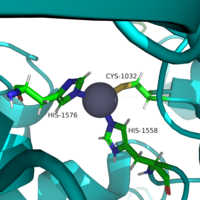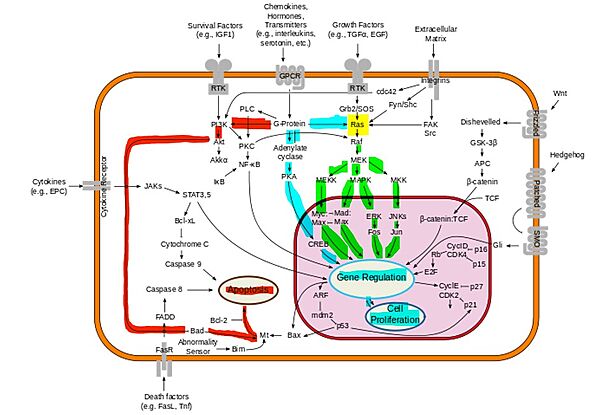Neurofibromin
From Proteopedia
(Difference between revisions)
| Line 10: | Line 10: | ||
[https://en.wikipedia.org/wiki/HEAT_repeat Heat domains] are domains found in cytoplasmic proteins that consist of four different proteins: [https://proteopedia.org/wiki/index.php/Huntingtin Huntingtin], [https://proteopedia.org/wiki/index.php/Elongation_factor elongation factor 3], [https://proteopedia.org/wiki/index.php/Protein_phosphatase protein phosphatase 2A], and TOR1. <ref name= ''Yoshimura''>DOI: 10.1242/jcs.185710</ref>. The HEAT/ARM cores are made up of many alpha helices. The N-HEAT/ARM and C-HEAT/ARM are rigid, which makes them critical in the rearrangement of the Gap-related and Sec14-PH domains. In the <scene name='90/904326/Heat/1'>closed conformation</scene>, the HEAT/ARM domains cover the GRD, preventing the binding of Ras through steric hinderance. <ref>DOI 10.1038/s41594-021-00687-2</ref> | [https://en.wikipedia.org/wiki/HEAT_repeat Heat domains] are domains found in cytoplasmic proteins that consist of four different proteins: [https://proteopedia.org/wiki/index.php/Huntingtin Huntingtin], [https://proteopedia.org/wiki/index.php/Elongation_factor elongation factor 3], [https://proteopedia.org/wiki/index.php/Protein_phosphatase protein phosphatase 2A], and TOR1. <ref name= ''Yoshimura''>DOI: 10.1242/jcs.185710</ref>. The HEAT/ARM cores are made up of many alpha helices. The N-HEAT/ARM and C-HEAT/ARM are rigid, which makes them critical in the rearrangement of the Gap-related and Sec14-PH domains. In the <scene name='90/904326/Heat/1'>closed conformation</scene>, the HEAT/ARM domains cover the GRD, preventing the binding of Ras through steric hinderance. <ref>DOI 10.1038/s41594-021-00687-2</ref> | ||
==== GRD domain ==== | ==== GRD domain ==== | ||
| - | The Gap-related domain, or <scene name='90/904326/Grd_highlighted/1'>GRD</scene>, is the catalytic domain of neurofibromin. It ranges from residues 1196 to 1547. <ref>DOI 10.1038/s41586-021-04024-x</ref> | + | The Gap-related domain, or <scene name='90/904326/Grd_highlighted/1'>GRD</scene>, is the catalytic domain of neurofibromin. It ranges from residues 1196 to 1547. <ref>DOI 10.1038/s41586-021-04024-x</ref> Its main catalytic mechanism is the hydrolysis of GTP-bound Ras into GDP-bound Ras, which converts Ras from its active form into its inactive form. The GRD provides an arginine residue, known as the arginine finger, to Ras. The location of the Gap-related domain is shifted between the <scene name='90/904326/Grdopen/1'>open conformation</scene> and closed conformations of neurofibromin. |
==== Sec-PH ==== | ==== Sec-PH ==== | ||
The <scene name='90/904326/Secph_highlighted/2'>Sec14-PH</scene> domain is the lipid-binding domain of neurofibromin, found in residues 1565 to 1835. <ref>DOI 10.1038/s41586-021-04024-x</ref> In the closed conformation of neurofibromin, the hydrophobic core is blocked by the Gap-related domain. The <scene name='90/904326/Secopen/1'>open conformation</scene> allows the hydrophobic core in the Sec cavity to be accessible and exposed. In neurofibromin, this cavity binds glycerophospholipids, which can induce conformational changes. <ref>DOI 10.1016/j.febslet.2012.06.006</ref> It is unclear if the Sec14-PH domain has a role in the RasGap activity of neurofibromin. | The <scene name='90/904326/Secph_highlighted/2'>Sec14-PH</scene> domain is the lipid-binding domain of neurofibromin, found in residues 1565 to 1835. <ref>DOI 10.1038/s41586-021-04024-x</ref> In the closed conformation of neurofibromin, the hydrophobic core is blocked by the Gap-related domain. The <scene name='90/904326/Secopen/1'>open conformation</scene> allows the hydrophobic core in the Sec cavity to be accessible and exposed. In neurofibromin, this cavity binds glycerophospholipids, which can induce conformational changes. <ref>DOI 10.1016/j.febslet.2012.06.006</ref> It is unclear if the Sec14-PH domain has a role in the RasGap activity of neurofibromin. | ||
| Line 24: | Line 24: | ||
In the transition from the closed state to the open state, several of the domains of neurofibromin rotate to make the binding site of neurofibromin more accessible . This rotation is able to occur due to the rotation of three connective linkers, L1, L2, and L3. <scene name='90/904326/L1/1'>L1</scene> is located between an alpha helix 48 in N-HEAT and an alpha helix 49 in GRD. G1190 is a potential hinge point when L1 rotates and pushes the alpha helices outwards to move the Gap-related domain. <scene name='90/904326/L3/1'>L3</scene> is located between the Sec14-PH domain and the C-HEAT/ARM and aids in the movement of the Sec14-PH domain. The proximity of L1 and L3 has to be close to facilitate the rotation of the domains. <scene name='90/904326/L2/1'>L2</scene> starts at the last helix in the Gap-related domain and extends to the Sec14-PH domain. Its primary role is to move the Sec14-PH domain away from the GRD. Without these rotations, the membrane binding sites are occluded and inaccessible. <ref name= ''Naschberger''>PMID:34707296</ref> | In the transition from the closed state to the open state, several of the domains of neurofibromin rotate to make the binding site of neurofibromin more accessible . This rotation is able to occur due to the rotation of three connective linkers, L1, L2, and L3. <scene name='90/904326/L1/1'>L1</scene> is located between an alpha helix 48 in N-HEAT and an alpha helix 49 in GRD. G1190 is a potential hinge point when L1 rotates and pushes the alpha helices outwards to move the Gap-related domain. <scene name='90/904326/L3/1'>L3</scene> is located between the Sec14-PH domain and the C-HEAT/ARM and aids in the movement of the Sec14-PH domain. The proximity of L1 and L3 has to be close to facilitate the rotation of the domains. <scene name='90/904326/L2/1'>L2</scene> starts at the last helix in the Gap-related domain and extends to the Sec14-PH domain. Its primary role is to move the Sec14-PH domain away from the GRD. Without these rotations, the membrane binding sites are occluded and inaccessible. <ref name= ''Naschberger''>PMID:34707296</ref> | ||
====SPRED-1 Protein==== | ====SPRED-1 Protein==== | ||
| - | The SPRED-1 protein <scene name='90/904325/Nf1_ras_spred1/2'>localizes neurofibromin</scene> to the cell membrane in to allow it to bind to the membrane oriented Ras protein<ref name= ''Naschberger''>PMID:34707296</ref>. <scene name='90/904325/Spred_1/2'>SPRED-1</scene> interacts with the N-terminal domain of NF to guide it to the membrane from the cytosol, where its C terminal domain will determine its target <ref name= ''Dunzendorfer-Matt''>PMID:27313208</ref>. | + | The SPRED-1 protein <scene name='90/904325/Nf1_ras_spred1/2'>localizes neurofibromin</scene> to the cell membrane in to allow it to bind to the membrane oriented Ras protein<ref name= ''Naschberger''>PMID:34707296</ref>. <scene name='90/904325/Spred_1/2'>SPRED-1</scene> interacts with the N-terminal domain of NF to guide it to the membrane from the cytosol, where its C terminal domain will determine its target <ref name= ''Dunzendorfer-Matt''>PMID:27313208</ref>. GAPex, a subdomain located in the GRD, has been found to help SPRED-1 bind to neurofibromin. <ref>DOI 10.1038/s41594-021-00687-2</ref> |
====Ras binding site==== | ====Ras binding site==== | ||
Revision as of 04:22, 21 April 2022
| |||||||||||
References
- ↑ Bergoug M, Doudeau M, Godin F, Mosrin C, Vallee B, Benedetti H. Neurofibromin Structure, Functions and Regulation. Cells. 2020 Oct 27;9(11). pii: cells9112365. doi: 10.3390/cells9112365. PMID:33121128 doi:http://dx.doi.org/10.3390/cells9112365
- ↑ Naschberger A, Baradaran R, Rupp B, Carroni M. The structure of neurofibromin isoform 2 reveals different functional states. Nature. 2021 Nov;599(7884):315-319. doi: 10.1038/s41586-021-04024-x. Epub 2021, Oct 27. PMID:34707296 doi:http://dx.doi.org/10.1038/s41586-021-04024-x
- ↑ Trovo-Marqui AB, Tajara EH. Neurofibromin: a general outlook. Clin Genet. 2006 Jul;70(1):1-13. doi: 10.1111/j.1399-0004.2006.00639.x. PMID:16813595 doi:http://dx.doi.org/10.1111/j.1399-0004.2006.00639.x
- ↑ Hall BE, Bar-Sagi D, Nassar N. The structural basis for the transition from Ras-GTP to Ras-GDP. Proc Natl Acad Sci U S A. 2002 Sep 17;99(19):12138-42. Epub 2002 Sep 4. PMID:12213964 doi:http://dx.doi.org/10.1073/pnas.192453199
- ↑ Cimino PJ, Gutmann DH. Neurofibromatosis type 1. Handb Clin Neurol. 2018;148:799-811. doi: 10.1016/B978-0-444-64076-5.00051-X. PMID:29478615 doi:http://dx.doi.org/10.1016/B978-0-444-64076-5.00051-X
- ↑ Bergoug M, Doudeau M, Godin F, Mosrin C, Vallee B, Benedetti H. Neurofibromin Structure, Functions and Regulation. Cells. 2020 Oct 27;9(11). pii: cells9112365. doi: 10.3390/cells9112365. PMID:33121128 doi:http://dx.doi.org/10.3390/cells9112365
- ↑ Yoshimura SH, Hirano T. HEAT repeats - versatile arrays of amphiphilic helices working in crowded environments? J Cell Sci. 2016 Nov 1;129(21):3963-3970. doi: 10.1242/jcs.185710. Epub 2016 Oct , 6. PMID:27802131 doi:http://dx.doi.org/10.1242/jcs.185710
- ↑ Lupton CJ, Bayly-Jones C, D'Andrea L, Huang C, Schittenhelm RB, Venugopal H, Whisstock JC, Halls ML, Ellisdon AM. The cryo-EM structure of the human neurofibromin dimer reveals the molecular basis for neurofibromatosis type 1. Nat Struct Mol Biol. 2021 Dec;28(12):982-988. doi: 10.1038/s41594-021-00687-2., Epub 2021 Dec 9. PMID:34887559 doi:http://dx.doi.org/10.1038/s41594-021-00687-2
- ↑ Naschberger A, Baradaran R, Rupp B, Carroni M. The structure of neurofibromin isoform 2 reveals different functional states. Nature. 2021 Nov;599(7884):315-319. doi: 10.1038/s41586-021-04024-x. Epub 2021, Oct 27. PMID:34707296 doi:http://dx.doi.org/10.1038/s41586-021-04024-x
- ↑ Naschberger A, Baradaran R, Rupp B, Carroni M. The structure of neurofibromin isoform 2 reveals different functional states. Nature. 2021 Nov;599(7884):315-319. doi: 10.1038/s41586-021-04024-x. Epub 2021, Oct 27. PMID:34707296 doi:http://dx.doi.org/10.1038/s41586-021-04024-x
- ↑ Scheffzek K, Welti S. Pleckstrin homology (PH) like domains - versatile modules in protein-protein interaction platforms. FEBS Lett. 2012 Aug 14;586(17):2662-73. doi: 10.1016/j.febslet.2012.06.006. Epub , 2012 Jun 19. PMID:22728242 doi:http://dx.doi.org/10.1016/j.febslet.2012.06.006
- ↑ Naschberger A, Baradaran R, Rupp B, Carroni M. The structure of neurofibromin isoform 2 reveals different functional states. Nature. 2021 Nov;599(7884):315-319. doi: 10.1038/s41586-021-04024-x. Epub 2021, Oct 27. PMID:34707296 doi:http://dx.doi.org/10.1038/s41586-021-04024-x
- ↑ Naschberger A, Baradaran R, Rupp B, Carroni M. The structure of neurofibromin isoform 2 reveals different functional states. Nature. 2021 Nov;599(7884):315-319. doi: 10.1038/s41586-021-04024-x. Epub 2021, Oct 27. PMID:34707296 doi:http://dx.doi.org/10.1038/s41586-021-04024-x
- ↑ Dunzendorfer-Matt T, Mercado EL, Maly K, McCormick F, Scheffzek K. The neurofibromin recruitment factor Spred1 binds to the GAP related domain without affecting Ras inactivation. Proc Natl Acad Sci U S A. 2016 Jul 5;113(27):7497-502. doi:, 10.1073/pnas.1607298113. Epub 2016 Jun 16. PMID:27313208 doi:http://dx.doi.org/10.1073/pnas.1607298113
- ↑ Lupton CJ, Bayly-Jones C, D'Andrea L, Huang C, Schittenhelm RB, Venugopal H, Whisstock JC, Halls ML, Ellisdon AM. The cryo-EM structure of the human neurofibromin dimer reveals the molecular basis for neurofibromatosis type 1. Nat Struct Mol Biol. 2021 Dec;28(12):982-988. doi: 10.1038/s41594-021-00687-2., Epub 2021 Dec 9. PMID:34887559 doi:http://dx.doi.org/10.1038/s41594-021-00687-2
- ↑ Frech M, Darden TA, Pedersen LG, Foley CK, Charifson PS, Anderson MW, Wittinghofer A. Role of glutamine-61 in the hydrolysis of GTP by p21H-ras: an experimental and theoretical study. Biochemistry. 1994 Mar 22;33(11):3237-44. doi: 10.1021/bi00177a014. PMID:8136358 doi:http://dx.doi.org/10.1021/bi00177a014
- ↑ Bunda S, Burrell K, Heir P, Zeng L, Alamsahebpour A, Kano Y, Raught B, Zhang ZY, Zadeh G, Ohh M. Inhibition of SHP2-mediated dephosphorylation of Ras suppresses oncogenesis. Nat Commun. 2015 Nov 30;6:8859. doi: 10.1038/ncomms9859. PMID:26617336 doi:http://dx.doi.org/10.1038/ncomms9859
- ↑ Lupton CJ, Bayly-Jones C, D'Andrea L, Huang C, Schittenhelm RB, Venugopal H, Whisstock JC, Halls ML, Ellisdon AM. The cryo-EM structure of the human neurofibromin dimer reveals the molecular basis for neurofibromatosis type 1. Nat Struct Mol Biol. 2021 Dec;28(12):982-988. doi: 10.1038/s41594-021-00687-2., Epub 2021 Dec 9. PMID:34887559 doi:http://dx.doi.org/10.1038/s41594-021-00687-2
- ↑ Abramowicz A, Gos M. Neurofibromin in neurofibromatosis type 1 - mutations in NF1gene as a cause of disease. Dev Period Med. 2014 Jul-Sep;18(3):297-306. PMID:25182393
- ↑ Cimino PJ, Gutmann DH. Neurofibromatosis type 1. Handb Clin Neurol. 2018;148:799-811. doi: 10.1016/B978-0-444-64076-5.00051-X. PMID:29478615 doi:http://dx.doi.org/10.1016/B978-0-444-64076-5.00051-X
- ↑ Ly KI, Blakeley JO. The Diagnosis and Management of Neurofibromatosis Type 1. Med Clin North Am. 2019 Nov;103(6):1035-1054. doi: 10.1016/j.mcna.2019.07.004. PMID:31582003 doi:http://dx.doi.org/10.1016/j.mcna.2019.07.004
- ↑ McCubrey JA, Steelman LS, Chappell WH, Abrams SL, Wong EW, Chang F, Lehmann B, Terrian DM, Milella M, Tafuri A, Stivala F, Libra M, Basecke J, Evangelisti C, Martelli AM, Franklin RA. Roles of the Raf/MEK/ERK pathway in cell growth, malignant transformation and drug resistance. Biochim Biophys Acta. 2007 Aug;1773(8):1263-84. doi:, 10.1016/j.bbamcr.2006.10.001. Epub 2006 Oct 7. PMID:17126425 doi:http://dx.doi.org/10.1016/j.bbamcr.2006.10.001
Proteopedia Page Contributors and Editors (what is this?)
Jordyn K. Lenard, Ryan D. Adkins, Michal Harel, OCA, Jaime Prilusky



